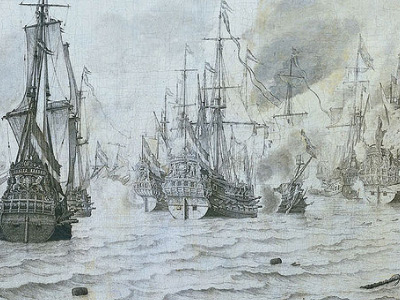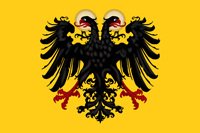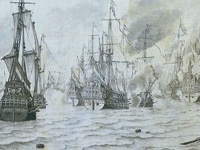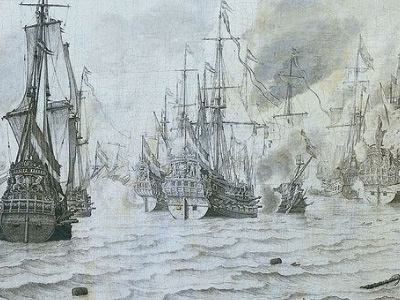Eighty Years' War (1568–1648)

Aftermath
New border between North and South
The Dutch Republic made some limited territorial gains in the Spanish Netherlands but did not succeed in regaining the entire territory lost before 1590. The end result of the war therefore was a permanent split of the Habsburg Netherlands into two parts: the territory of the Republic roughly corresponds with present-day Netherlands and the Spanish Netherlands corresponds approximately with present-day Belgium, Luxembourg and Nord-Pas-de-Calais.
Overseas, the Dutch Republic The Dutch Republic was a confederation that existed from 1579, during the Dutch Revolt, to 1795. It was a predecessor state of the Netherlands and the first fully independent Dutch nation state. Although the state was small and contained only around 1.5 million inhabitants, it controlled a worldwide network of seafaring trade routes. The income from this trade allowed the Dutch Republic to compete militarily against much larger countries. It amassed a huge fleet of 2,000 ships, initially larger than the fleets of England and France combined. gained, through the intermediary of its two chartered companies, the United East India Company (VOC) and the Dutch West India Company (WIC), important colonial possessions, largely at the expense of Portugal. The peace settlement was part of the comprehensive 1648 Peace of Westphalia, which formally separated the Dutch Republic from the Holy Roman Empire
The Dutch Republic was a confederation that existed from 1579, during the Dutch Revolt, to 1795. It was a predecessor state of the Netherlands and the first fully independent Dutch nation state. Although the state was small and contained only around 1.5 million inhabitants, it controlled a worldwide network of seafaring trade routes. The income from this trade allowed the Dutch Republic to compete militarily against much larger countries. It amassed a huge fleet of 2,000 ships, initially larger than the fleets of England and France combined. gained, through the intermediary of its two chartered companies, the United East India Company (VOC) and the Dutch West India Company (WIC), important colonial possessions, largely at the expense of Portugal. The peace settlement was part of the comprehensive 1648 Peace of Westphalia, which formally separated the Dutch Republic from the Holy Roman Empire The Holy Roman Empire was a political entity in Western, Central, and Southern Europe that developed during the Early Middle Ages and continued until its dissolution in 1806 during the Napoleonic Wars. From the accession of Otto I in 962 until the twelfth century, the Empire was the most powerful monarchy in Europe. The empire reached the apex of territorial expansion and power in the mid-thirteenth century, but overextending led to partial collapse.. In the course of the conflict, and as a consequence of its fiscal-military innovations, the Dutch Republic emerged as a Great Power, whereas the Spanish Empire
The Holy Roman Empire was a political entity in Western, Central, and Southern Europe that developed during the Early Middle Ages and continued until its dissolution in 1806 during the Napoleonic Wars. From the accession of Otto I in 962 until the twelfth century, the Empire was the most powerful monarchy in Europe. The empire reached the apex of territorial expansion and power in the mid-thirteenth century, but overextending led to partial collapse.. In the course of the conflict, and as a consequence of its fiscal-military innovations, the Dutch Republic emerged as a Great Power, whereas the Spanish Empire The Spanish Empire was a colonial empire governed by Spain and its predecessor states between 1492 and 1976. One of the largest empires in history, it was the first to usher the European Age of Discovery and achieve a global scale, controlling vast territory. It was one of the most powerful empires of the early modern period, reaching its maximum extent in the 18th century. lost its European hegemonic status.
The Spanish Empire was a colonial empire governed by Spain and its predecessor states between 1492 and 1976. One of the largest empires in history, it was the first to usher the European Age of Discovery and achieve a global scale, controlling vast territory. It was one of the most powerful empires of the early modern period, reaching its maximum extent in the 18th century. lost its European hegemonic status.
Political Situation
Soon after the conclusion of the peace the political system of the Republic entered a crisis. The same forces that had sustained the Oldenbarnevelt regime in Holland, and that had been so thoroughly shattered after Maurice's 1618 coup, had finally coalesced again around what was to become known as the States-Party faction. This faction had slowly been gaining prominence during the 1640s until they had forced Frederick Henry to support the peace. And now they wanted their peace dividend. The new stadtholder, William II, on the other hand, far less adept as a politician than his father, hoped to continue the predominance of the stadtholderate and the Orangist faction (mostly the aristocracy and the Counter-Remonstrant regents) as in the years before 1640. Above all, he wanted to maintain the large wartime military establishment, even though the peace made that superfluous. The two points of view were irreconcilable. When the States-Party regents started to cut down the size of the standing army to a peace-time complement of about 30,000, a struggle for power in the Republic ensued. In 1650 stadtholder William II finally followed the path of his uncle Maurice and seized power in a coup d'état, but he died a few months later from smallpox. The power-vacuum which followed was quickly filled by the States-Party regents, who founded their new republican regime that has become known as the First Stadtholderless Period.
Dutch trade on the Iberian Peninsula and the Mediterranean exploded in the decade after the peace, as did trade in general, because trade patterns in all European areas were so tightly interlocked via the hub of the Amsterdam Entrepôt. Dutch trade in this period reached its pinnacle; it came to completely dominate that of competing powers, like England The Kingdom of England was a sovereign state on the island of Great Britain from about 927, when it emerged from various Anglo-Saxon kingdoms, until 1 May 1707, when it united with Scotland to form the Kingdom of Great Britain. The Viking invasions of the 9th century upset the balance of power between the English kingdoms, and native Anglo-Saxon life in general. The English lands were unified in the 10th century in a reconquest completed by King Æthelstan in 927., that had only a few years previously profited greatly from the handicap the Spanish embargoes posed to the Dutch. Now the greater efficiency of Dutch shipping had a chance to be fully translated into shipping prices, and the competitors were left in the dust. The structure of European trade therefore changed fundamentally in a way that was advantageous to Dutch trade, agriculture and industry. One could truly speak of Dutch primacy in world trade. This not only caused a significant boom for the Dutch economy, but also much resentment in neighbouring countries, like first the Commonwealth of England and later France
The Kingdom of England was a sovereign state on the island of Great Britain from about 927, when it emerged from various Anglo-Saxon kingdoms, until 1 May 1707, when it united with Scotland to form the Kingdom of Great Britain. The Viking invasions of the 9th century upset the balance of power between the English kingdoms, and native Anglo-Saxon life in general. The English lands were unified in the 10th century in a reconquest completed by King Æthelstan in 927., that had only a few years previously profited greatly from the handicap the Spanish embargoes posed to the Dutch. Now the greater efficiency of Dutch shipping had a chance to be fully translated into shipping prices, and the competitors were left in the dust. The structure of European trade therefore changed fundamentally in a way that was advantageous to Dutch trade, agriculture and industry. One could truly speak of Dutch primacy in world trade. This not only caused a significant boom for the Dutch economy, but also much resentment in neighbouring countries, like first the Commonwealth of England and later France The Kingdom of France is the historiographical name or umbrella term given to various political entities of France in the medieval and early modern period. It was one of the most powerful states in Europe since the High Middle Ages. It was also an early colonial power, with possessions around the world. Colonial conflicts with Great Britain led to the loss of much of its North American holdings by 1763. The Kingdom of France adopted a written constitution in 1791, but the Kingdom was abolished a year later and replaced with the First French Republic.. Soon, the Republic was embroiled in military conflicts with these countries, which culminated in their joint attack on the Republic in 1672. They almost succeeded in destroying the Republic in that year, but the Republic rose from its ashes and by the turn of the century, she was one of the two European power centres, together with the France of Louis XIV of France.
The Kingdom of France is the historiographical name or umbrella term given to various political entities of France in the medieval and early modern period. It was one of the most powerful states in Europe since the High Middle Ages. It was also an early colonial power, with possessions around the world. Colonial conflicts with Great Britain led to the loss of much of its North American holdings by 1763. The Kingdom of France adopted a written constitution in 1791, but the Kingdom was abolished a year later and replaced with the First French Republic.. Soon, the Republic was embroiled in military conflicts with these countries, which culminated in their joint attack on the Republic in 1672. They almost succeeded in destroying the Republic in that year, but the Republic rose from its ashes and by the turn of the century, she was one of the two European power centres, together with the France of Louis XIV of France.
Portugal was no party in the peace and the war overseas between the Republic and that country resumed fiercely after the expiration of the ten-year truce of 1640. In Brazil and Africa the Portuguese managed to reconquer most of the territory lost to the WIC in the early 1640s after a long struggle. However, this occasioned a short war in Europe in the years 1657–60, during which the VOC completed its conquests in Ceylon and the coastal areas of the Indian subcontinent. Portugal was forced to indemnify the WIC for its losses in Brazil.
HISTORY

RESOURCES
This article uses material from the Wikipedia article "Eighty Years' War (1568–1648)", which is released under the Creative Commons Attribution-Share-Alike License 3.0.
© Stories Preschool. All Rights Reserved.









